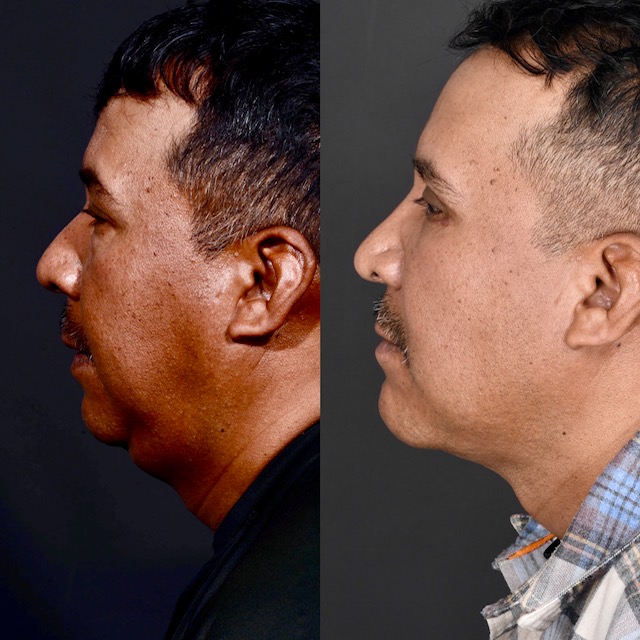Male Facial Aesthetic Surgery: Precision Techniques for Natural, Masculine Results
Facial aesthetic surgery for men is about restoring youthful definition without softening the natural masculine character of the face. Subtle refinements can make a man appear rested, confident, and more athletic while maintaining authenticity. Dallas plastic surgeon Dr. Sam Jejurikar performs advanced facial rejuvenation procedures designed specifically for male anatomy, focusing on the eyes, jawline, and neck.
Eyelid Surgery: Restoring an Alert, Energetic Appearance
The eyes often reveal fatigue before any other facial feature. Men commonly develop sagging upper lids and puffiness beneath the eyes that make them appear tired or older than they feel.
Eyelid surgery, or blepharoplasty, removes excess skin and repositions or conserves fat to smooth the contour around the eyes. The goal is not to create a wide-eyed or operated look but to subtly refresh the eyes while preserving a masculine appearance. Most men see dramatic improvements with small, precise adjustments that retain the natural heaviness of the brow and upper lid, which is characteristic of a masculine eye.
Facelift and Neck Lift: Structural Refinement for the Jawline
The male facelift must enhance jawline definition while maintaining angularity and strength. The foundation of a lasting, natural result lies in lifting the superficial musculoaponeurotic system (SMAS) rather than relying solely on skin tightening.
By elevating the SMAS layer, deeper support is restored, smoothing the cheeks and lower face while tightening the jawline. However, the vector and height of SMAS elevation are critical. Elevating it too high in the midface can feminize the face by softening the natural transitions between the cheek and lower eyelid. For male patients, a lateral and slightly inferior vector preserves a chiseled appearance and maintains masculine contour.
The continuity of the SMAS and platysma is equally important. These layers are interconnected, forming a single anatomic unit that spans the lower face and neck. Lifting and redraping them in harmony allows for a smooth transition from the jawline to the upper neck. When executed correctly, this approach defines the mandibular border, sharpens the cervicomental angle, and eliminates jowling without creating a tight or unnatural look.
Maintaining this deep layer continuity is what differentiates a high-quality male facelift and neck lift from procedures that focus only on skin tightening.
Neck Liposuction: When It Works and When It Doesn’t
Some men in their 30s and 40s develop fullness under the chin or along the jawline without significant skin laxity. For these patients, neck liposuction can be an excellent option. It removes excess fat and improves the contour of the lower face with minimal downtime. Ideal candidates have good skin elasticity, a well-defined underlying jawbone, and no major neck banding or platysmal laxity.
In patients with loose skin or visible muscle separation, liposuction alone can worsen contour irregularities. These men benefit from combining liposuction with a neck lift to tighten deeper structures and remove redundant skin. A detailed evaluation determines which approach will achieve a clean, masculine neck profile.
Case Examples
Case 1: Comprehensive Neck Lift with Eyelid Rejuvenation
This patient presented with significant laxity of the lower face and neck, along with heaviness of the upper and lower eyelids.
A deep-plane neck lift was performed with precise SMAS and platysma elevation, creating a sharp, athletic jawline and improved cervicomental angle. Upper and
lower blepharoplasty removed excess skin and reduced puffiness while maintaining a masculine brow and lid contour.
The overall effect is refreshed and powerful. He looks fitter and younger without appearing overdone.


Case 2: Neck Lift for Jawline Definition
This patient sought correction of early jowling and neck fullness but wanted to avoid any sign of surgery.
A lower facelift and neck lift tightened the SMAS-platysma complex, restoring definition along the jaw and neck. The vector of lift was kept lateral and slightly inferior to preserve masculine angles in the midface.
He now has a clean neckline and sharper profile that communicates youth and confidence while maintaining complete naturalness.


View this post on Instagram
Case 3: Liposuction with Eyelid and Buccal Fat Refinement
This younger male patient had excellent skin elasticity but excess fat beneath the chin and along the jawline, along with fullness in the cheeks and lower eyelid bags.
A combination of whole neck liposuction, upper and lower blepharoplasty, buccal fat pad removal, and rhinoplasty refined the facial balance. Liposuction enhanced his jawline, blepharoplasty brightened his eyes, and conservative buccal fat reduction chiseled his midface without hollowing.
His rhinoplasty improved nasal proportion while maintaining a strong, masculine bridge. Together, these procedures achieved harmony and structure without softening his natural features.


Recovery and Results
Most men return to work within 10 to 14 days, depending on the procedures performed. Swelling resolves gradually, with continued refinement over several months. Dr. Jejurikar often incorporates hyperbaric oxygen therapy, lymphatic drainage, and compression protocols to accelerate healing and minimize downtime. The final result is a naturally refreshed appearance that communicates vitality, not surgery.
The Modern Male Approach
Today’s male facial aesthetic surgery focuses on precision and restraint. By understanding the structural nuances of male anatomy and the directional forces of facial support layers, Dr. Jejurikar creates results that look strong, not stretched. Whether it involves eyelid rejuvenation, a lower face and neck lift, or neck liposuction, the guiding principle is consistency of contour and preservation of masculine identity.
Schedule a Consultation
If you are considering facial rejuvenation, schedule a private consultation with Dr. Sam Jejurikar at Dallas Plastic Surgery. Discover how modern surgical techniques can redefine your jawline, restore confidence, and help you look as sharp and energetic as you feel.







